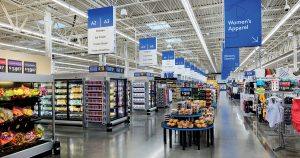The Supply Side: Store displays, layouts evolve during COVID
by October 30, 2020 10:16 am 1,712 views

The consumer packaged goods retail operations and customer experience have taken some wild turns during the COVID-19 pandemic, prompting retailers to revise store layouts and institute new cleaning protocols.
Many suspended or dramatically revised marketing and promotional activity as demand spikes overshot inventory, and consumers evoked new shopping patterns and bigger basket purchases from April through August.
Marketing research firm IRI recently looked at the impact COVID-19 has had on the food business and shrinking store displays that could be the new normal in the post-COVID-19 world. IRI found that in-store displays are being displaced to accommodate distancing. On average, stores across the U.S. had five fewer displays per week than the same period a year ago. Grocery areas for edible foods had an average of 3.6 fewer weekly displays, while non-edible grocery had 3.1 fewer weekly displays compared to a year ago. The survey period ran from Feb. 23 to Sept. 6.
According to the report, the new retail protocol also calls for wider aisles and more free space, further squeezing suppliers in specific categories. Lobby areas are more precise with slightly smaller displays on the front and back endcap areas. The store perimeter was impacted the most with roughly two fewer display locations. The same was true with in-aisle displays that are hung over shelving or standing alone in the aisle.
IRI found those categories losing the most space in stores were cookies and candy, seeing an average of 12 to 14 fewer displays from a year ago. Nuts also saw less space with eight fewer average displays, while beer averaged almost four more displays per store. More room went to healthcare items for kids, bleach, soap, baby formula, pre-mixed cocktails, dog treats and analgesic over-the-counter medications.
IRI also found most departments have been challenged with a diminishing assortment of items during the February to September surveys. Frozen foods averaged 13 fewer products per display and four fewer displays on average. Alcoholic beverages have 10 fewer items per display, but two more displays on average as retailers like Walmart worked with local craft brewers to add inventory to their stores.
Beauty categories had 16 fewer items per display and five fewer displays, while general merchandise inventories were slightly higher, with three more items per display. However, this category has lost about five of its typical displays during this period. Health items were in short supply and took up less store space because the demand outpaced inventory.

As consumers spend more time at home, items to care for the house were also in short supply, with an average of six fewer items per display and nearly 15 fewer displays in stores overall.
IRI found that even though the display shifts continue, the contribution from sales has remained relatively steady. There have been fewer features, but demand has been higher than usual in many categories.
IRI reports that the reduction in displays has impacted top national brands more than private brands. However, there has been some erosion among private brands with fewer items overall and less focus on this area amid the pandemic.
Continual evaluation will be required to ensure the “right’”categories get display space — merchandising strategies that worked during peak stockpiling of mid-March and subsequent stock-up periods may no longer work as behavior evolves, the report states.
WALMART REDESIGN
Recently, Walmart unveiled its newest Supercenter redesign. It’s aimed at more space and in line with the retail giant’s omnichannel shopping experience goals. Walmart said the redesign was inspired by airport wayfinding signs that allow shoppers to navigate the large footprint better.
“We developed simple yet thoughtful designs to replicate these navigation efficiencies, which will help us move customers through the store more quickly. We also optimized product layout, bringing greater visibility to key items throughout the store, including dedicated in-store sections for electronics, toys, baby products and more,” said Janey Whiteside, chief customer officer at Walmart U.S.
She said the design was developed through a customer-centric lens to create an elevated experience when shopping with the Walmart app.
“By creating a system that acknowledges our app navigation from beginning to end, we create an optimized omni-experience for both customers and associates,” Whiteside added.
The new design allows for contactless checkout and payment when using Walmart Pay. Walmart+ customers also can use scan and go to speed up their checkout process.
Whiteside said the new concept is being tested in select stores like the Supercenter on Elm Springs Road in Springdale and will be rolled out to more stores this fall and next year.
EDITOR’S NOTE: The Supply Side section of Talk Business & Politics focuses on the companies, organizations, issues and individuals engaged in providing products and services to retailers. The Supply Side is managed by Talk Business & Politics and sponsored by Propak Logistics.
